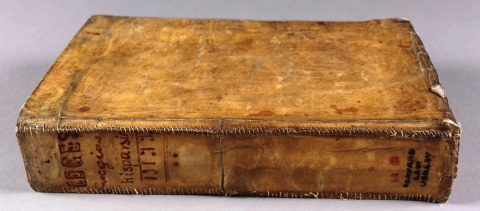Around the turn of the 20th century—a golden age for libraries in America—the Snead Bookshelf Company of Louisville, Ky., developed a new system for large-stack library shelving. Snead’s multifloor stack systems can still be seen in many important libraries built in that era, for instance at Harvard, Columbia, the Vatican, and at Bryant Park in New York City. Besides storing old bundles of bound paper, Snead’s stacks provided load-bearing structural support to these venerable buildings. To remove the books would literally invite collapse.
Shared posts
The Mystery of Zebra Stripes, Solved
The zebra’s distinctive black-and-white streaks are there to provide camouflage, or body-temperature regulation, or confuse the heck out of lions, right? Nope.
Should We Rank Colleges Based on Their Graduates’ Earnings?
I recently reported on PayScale’s newest batch of college rankings, which compare how much a school’s graduates earn to how much they pay for tuition. In other words, it calculates each institution’s financial return on investment, which seems a far saner way to look at the value of a degree than anything that U.S. News, for instance, has cooked up. (In case you were wondering, PayScale ranked Harvey Mudd College at No. 1, with a $1.094 million 20-year net ROI on $116,800 tuition; MIT, Caltech, and Stanford came in at Nos. 2, 3, and 4, respectively.)
Non, on n’a pas trouvé un émoticône dans un poème de 1648 :(
Mais comme le note Ben Zimmer sur Slate.com, Bonnie Taylor-Blake qui a mis en ligne ces scans a remarqué que sur la page suivante, on retrouve la même double ponctuation.
«Je ne pense pas que la retranscription du discours de Lincoln nous faisait un clin d’œil, et je suis encore plus sûr que Herrick n’avait pas pour intention de nous faire tourner la tête avec son petit smiley. Et ce n’est pas que dans le texte de Herrick. La combinaison deux points/parenthèse est facilement trouvable dans d’autres textes du XVIIe siècle, en anglais.»
Benjamin Schmidt, chercheur en lettres numériques à l’Université de Northwestern, à côté de Chicago, aux Etats-Unis, a cherché les récurrences de cette combinaison sur Open Library. Certains des résultats étaient des erreurs de reconnaissance optique de caractères (OCR). Mais la plupart des réponses n’était pas des erreurs, mais bien une série de ponctuation normale, même si cela paraît un peu ... Lire la suite
This is the system Apple used to test iPhone software in 2006

The Wall Street Journal has a story about the birth of the iPhone (which I am still a little startled to realize is only seven years old ... I think my memory is merging iPhones and iPods into a sense of the presence of a single iThing). In an accompanying blog post, they shared this photo taken by Apple engineers, showing the system that was used to test out prototypes of iPhone software before its release. According to the blog post, the system "tethered a plastic touch-screen device – code-named “Wallaby” – to an outdated Mac to simulate the slower speeds of a phone hardware."
Parrot says 'WTF' (video)
[Video Link, thanks Dean Putney ]![]()
Two Older Women Take Their First Flight On A Plane Together
The cameras of the “Vodafone Firsts” series documented the process of two older Dutch women, An and Ria, who were preparing to go on their first plane ride. An, the more subdued of the two, used virtual reality tools to get her past her paralyzing fear of flying while Ria headed straight for the roller coaster. When they got on the plane, however, the two women found that the ride wasn’t nearly as scary as they suspected it would be and let themselves have a little fun on the way to Barcelona, Spain.
The two women, who had just met that day, became fast friends and held onto each other both literally and figuratively through the entire adventure. Simply lovely.
Dit is echt de leukste dag van mijn leven geweest (This is the best day of my life)
images via Vodafone
Unsuspecting Dachshund Crawls Inside Coat And Becomes a Barking Sleeve
In this adorable video posted by Matt Rundquist, an unsuspecting dachshund crawls inside coat and becomes a barking sleeve, really confusing the other dog in the room.
A SpongeBob SquarePants Version of the Music Video ‘Evolution of Get Lucky’ by PJ Nova
Bobart Movie has created a SpongeBob SquarePants version of musician PV Nova‘s “Evolution of Get Lucky,” a fantastic reimagined cover of the hit song “Get Lucky” by Daft Punk. This time around, characters from the animated television series SpongeBob SquarePants sing and dance as they span chronologically through the decades of 1920 to 2020.
Here is PJ Nova’s original music video:
submitted via Laughing Squid Tips
Myna Bird Speaks Japanese While Trying to Answer the Phone
Abe-chan the pet myna bird displays a remarkable ability to speak Japanese in this 2012 video uploaded by his human. The bird converses carries on a brief conversation after his owner attempts unsuccessfully to get him to answer the phone. Abe is a Common Hill Myna, a species renowned for vocal mimicry akin to that of the African Grey Parrot. For those curious about what the bird is is saying, Reddit users have taken it upon themselves to translate the conversation.
Bird:” ‘Uhm Hello, this is the Ono family.”
Bird: “What’s wrong?”
Owner: “Abe-chan, you’re a little too early. Once the phone’s picked up, then properly say hello.”
Bird: “Okay, understood.”
There are a number of other videos of Abe-chan in action over on the bird’s YouTube account.
via reddit
Texting driver on cyclist she struck: "I just don't care"
A woman in Australia was fined $4500 and lost her driver's license for 9 months after pleading guilty to dangerous driving Monday. According to The Standard, she struck the cyclist at 7:20 p.m. near Koroit, Victoria, having used her phone 44 times during the short drive from Warrnambool. Most striking, though, is what Kimberly Davis told investigators.
“I just don’t care because I’ve already been through a lot of bullshit and my car is like pretty expensive and now I have to fix it,” she told a police officer. “I’m kind of pissed off that the cyclist has hit the side of my car. I don’t agree that people texting and driving could hit a cyclist.”
Study calls for placebo-controlled trials of parachute effectiveness
Hearing lips and seeing voices
This video explains the weirdness of the McGurk effect, a perceptual illusion demonstrating that understanding speech is not just about what we hear, but also what we see. You can learn more about the McGurk effect at Yale's Haskins Laboratories dedicated to the science of the spoken and written wordl. (via Imaginary Foundation)![]()
Breather is like an Airbnb by the hour
 If you are in New York or Montreal and need a place to work, chill-out, or engage in an activity you'd like to perform behind closed doors, check out Breather. For $15 - $25 per hour, you can rent an apartment and take care of business.
If you are in New York or Montreal and need a place to work, chill-out, or engage in an activity you'd like to perform behind closed doors, check out Breather. For $15 - $25 per hour, you can rent an apartment and take care of business.![]()
Japanese game-show asks celebs to eat household objects that may or may not be chocolates

Celeste writes, "Japanese sokkuri ('look alike') sweets are desserts designed to look like other, everyday things. This Japanese TV show showed contestants a room full of seemingly ordinary objects, and then had them guess which ones were sokkuri sweets by biting into them." ![]()
In space, everyone can drink your pee
Punishments for scientists who don't make research open access
Fish don't need no stinking eyes
INAT, A Super Simple Mapping Standard for Transit Systems
Architect Jug Cerovic has created a simple mapping standard for transit systems, called INAT, that he has used to create easy to read maps for transit systems around the world. All INAT maps share the same symbols and colors, and feature simplified transit routes (with no more than 5 bends for most routes) and enlarged city centers for legibility.
images by Jug Cerovic
via designboom
Old Books Bound in Human Skin Found in Harvard Libraries (and Elsewhere in Boston)

For at least a decade now, the “death of print” has seemed all but inevitable. Amidst all the nostalgia for printed literature, it’s easy to forget that mass-produced books and media, and a literate population, are fairly recent phenomena in human history. Books—whether printed or hand-copied—had a totemic status for thousands of years, given that they were kept under the protection of an educated elite, who were among the few able to read and interpret them. Even after the age of printing, books were rare and hard to come by, largely too expensive for most people to afford until the advent of paperbacks.
A grisly reminder of the book’s status as an almost magical object surfaced in Harvard’s rare book collection a few years ago. In 2006, librarians discovered at least three volumes bound in human skin—and as travel site Roadtrippers reports, “in one case, skin harvested from a man who was flayed alive.” Gruesome as all this seems, the practice of skin-binding was apparently not the sole province of serial killers:
As it turns out, the practice of using human skin to bind books was actually pretty popular during the 17th century. It’s referred to as Anthropodermic bibliopegy and proved pretty common when it came to anatomical textbooks. Medical professionals would often use the flesh of cadavers they’d dissected during their research.
The book supposedly made of flayed skin is a Spanish law text from the seventeenth century titled Practicarum quaestionum circa leges regias (above). Despite an inscription naming the deceased and claiming his skin as the binding, this volume has actually just been identified as sheepskin—according to a Harvard Law Library blog post from yesterday—”thanks to a technique for identifying proteins that was developed in the last twenty years.” Speculates the Law Library post:
Perhaps before it arrived at HLS [Harvard Law School] in 1946, the book was bound in a different binding at some point in its history. Or perhaps the inscription was simply the product of someone’s macabre imagination.
Nevertheless, other human skin-bound books exist—as far as librarians and scientists can determine. Former director of libraries for the University of Kentucky Lawrence S. Thompson claims that the practice dates as far back as a 13th century French Bible and became more common in the 16th and 17th centuries. A 1933 Crimson article mentioned another skin-bound book in a collection of miniature books, including this graphic detail: “removal of 20 square inches of skin from his back failed to impair the health of its donor, who is still alive and in the best of condition.”
Another skin-bound volume, which Thompson calls “the most famous of all anthropodermic bindings,” resides across the river from Harvard at independent library the Boston Athenaeum. Called The Highwayman: Narrative of the Life of James Allen alias George Walton (above), the book is a memoir of the titular outlaw. The author, reports the Crimson, “was impressed by the courage of a man whom he once attacked, and when Walton was facing execution, he asked to have his memoir bound in his own skin and presented to the brave man.” Thumb through (so to speak) a digital copy of Walton’s 1837 memoir above, and imagine being the recipient of such a gift.
via Roadtrippers
Related Content:
Medieval Cats Behaving Badly: Kitties That Left Paw Prints … and Peed … on 15th Century Manuscripts
How a Book Thief Forged a Rare Edition of Galileo’s Scientific Work, and Almost Pulled it Off
Josh Jones is a writer and musician based in Durham, NC. Follow him at @jdmagness
Old Books Bound in Human Skin Found in Harvard Libraries (and Elsewhere in Boston) is a post from: Open Culture. Follow us on Facebook, Twitter, and Google Plus, or get our Daily Email. And don't miss our big collections of Free Online Courses, Free Online Movies, Free eBooks, Free Audio Books, Free Foreign Language Lessons, and MOOCs.
The post Old Books Bound in Human Skin Found in Harvard Libraries (and Elsewhere in Boston) appeared first on Open Culture.
Nobody wants a push-button orgasm
Amazing trick will distort your vision and make you hallucinate
21 Of The Most Beautiful Japanese Cherry Blossom Photos Of 2014
The delicate pink sakura, or cherry blossom, is associated primarily with the culture of its native Japan. These trees blossom throughout Japan every spring, but their beauty never gets old, so we’ve collected some of our favorite photos of this year’s cherry blossoms in Japan.
In Japan, the blossoming of the sakura begins in April, when students go back to school or people go back to work after the holidays. Japan’s national weather service even tracks the movement of the “sakura front,” which is an imaginary line that travels south-to-north every season and heralds the blooming of the sakura. This line’s progression in Japan is marked on this convenient sakura calendar.
The cherry blossom is tied to the ancient Japanese tradition of hanami, or picnicking under a sakura tree. The fact that the cherry blossom has heavily featured in ancient Japanese art has made it a staple of both historical and modern Japanese aesthetic. Although it is also native to China and Korea, it is generally associated primarily with Japanese culture, which is why it often accompanies the Japanese diaspora into cities around the world.
While sakuras are probably best viewed with a Japanese castle, mountain or garden in the backdrop, they might also be planted somewhere in your city as well. They provide a great opportunity to go have a beautiful springtime picnic!
Image credits: 紅襪熊
Image credits: Sue Hsu
Image credits: onotch
Image credits: Masato Mukoyama
Image credits: ta3mam
Image credits: Noisy Paradise
Image credits: Takeshi Tanaka
Image credits: Yukatan
Image credits: Akio Iwanaga
Image credits: tomosang
Image credits: Yuga Kurita
Image credits: zhangning
Image credits: torne
Image credits: Hikaruno Mikoto
Image credits: Saori
Image credits: Batistini Gaston
Image credits: Haru Digital Photo
Image credits: Nobuhiro Suhara
Image credits: poojartiwari
Image credits: Ryosuke Yagi
Image credits: Danny Dungo
21 Of The Most Beautiful Japanese Cherry Blossom Photos Of 2014 originally appeared on Bored Panda on April 4, 2014.
Mad Lettering Skills
Designer Tom Williams filmed two gentlemen road painters painting a bus stop. They show some mad lettering skills! You’d think they’d use a pencil but they don’t.
The Expert
I have in fact been in a meeting just like this one.
(via Seth Godin)
A Tour of the British Isles in Accents
Dialect coach Andrew Jack offers a tour of the British Isles through the various accents of its residents in this fascinating short video. Jack has provided dialect training on many film and theater projects, including the Lord of the Rings trilogy, for which he developed the Middle Earth accents. The video was created by PJamBarker and is based on a BBC Radio 4 feature.
via reddit
Here’s How Your City Would Look If The Ads Were Replaced By Classical Paintings
Creative French artist Etienne Lavie has created a wonderful series of images that picture what several major European cities might look like if all of the advertisements were replaced by classical paintings. The series is aptly named – “OMG who stole my ads?”
We’ve written a lot at Bored Panda about creative print ads and ambient advertisements, but don’t we all sometimes wish that public advertisements would just go away? That seems to be the idea behind Lavie’s playful work.
She uses Milan and Paris as her backdrop – cities that are inextricably linked, architecturally and historically, to the development of classical art as we know it. So, in some sense, the modern ads plastered on every available surface in these cities are even more out of place than they are in newer cities like New York. Replacing modern in-your-face public ads with classical artwork seems to return these cities to their natural state of being.
Lavie created these images by photographing the sites in question and then adding the artwork digitally, so unfortunately, the streets of these beautiful cities haven’t actually been filled with classical art. But one can dream…
Source: etiennelavie.fr | Twitter (via)
Here’s How Your City Would Look If The Ads Were Replaced By Classical Paintings originally appeared on Bored Panda on March 31, 2014.
Pete Holmes Tries to Figure Out How to Market Street Fighter’s Dhalsim (Kumail Nanjiani)
“I’m a fighter. People love fighting. Yoga fighter! I’m the guy right now!”
On a new episode of Street Fighter Red Tape, Pete Holmes the bureaucrat sits down with Street Fighter character Dhalsim, played by Kumail Nanjiani, to figure out how to market the odd fighter.
There Are More Ways To Arrange a Deck of Cards Than Atoms on Earth
When you're shuffling a deck of cards, you're trying your best to ensure everything gets as mixed up as possible. But it turns out you might not have to try so hard. In this wonderful TedEd animation, Yannay Khaikin outlines the staggering number of ways a deck of 52 cards can be arranged.











































































